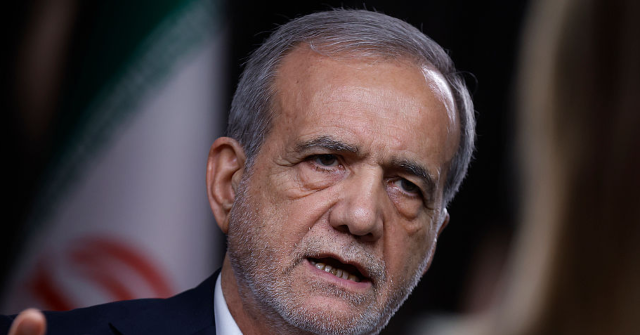Iranian President Masoud Pezeshkian, who is subordinate to “supreme leader” Ayatollah Ali Khamenei, described the inevitable need to relocate the capital of his country out of Tehran during remarks on Thursday, citing an unsolvable water and overpopulation crisis.
Pezeshkian has addressed the dire situation of Tehran’s infrastructures and utilities, particularly the lack of rainfall and drying reservoirs, in the past, but this week he insisted that no solution exists to continue maintaining the city’s status as the country’s capital.
“I also told the leader of the revolution that we must shift the capital toward the Persian Gulf,” Pezeshkian reportedly said, according to Russian news agency Tass. “Nowadays, we don’t have an alternative anymore. We are compelled to do so. If things remain the same, we will face difficulties.”
The independent outlet Iran International reported that Pezeshkian made his remarks in a nationally televised address, discussing details of the meager rainfall in the city that threatened to leave its estimated 10 million residents without water.
“Last year, rainfall was 140 millimeters, while the standard is 260 millimeters. That means rainfall has fallen by about 50 to 60 percent. This year, the situation is just as critical,” Pezeshkian reportedly warned, explaining that moving the capital was “not a choice, it is a mandate.”
Iran’s water supply has been a significant challenge for the functionally socialist, Islamist government of the country for decades. As Iran International noted, “19 major dams nationwide are operating at below 20 percent capacity, while satellite analysis indicates Amir Kabir reservoir outside Tehran is at just 6 percent of usable volume.” Water has been the cause of a major diplomatic crisis with the jihadist Taliban in neighboring Afghanistan, as the two countries share access to the Helmand River and have repeatedly accused each other of hoarding water. The Taliban threatened to “conquer” Iran in 2023 after a border shootout related to water access along the Helmand River.
Iranian leaders have discussed moving the capital from Tehran for decades, but Pezeshkian first began reviving the idea as a realistic project in November. Speaking to officials with an engineering firm tied to the Islamic Revolutionary Guard Corps (IRGC), a U.S.-designated terrorist organization, Pezeshkian said on that occasion, similarly, that Iran had “no choice” but to build a new capital.
“Whatever we do, we’re just wasting time,” he lamented. “We have no choice but to move the country’s economic and political center to the south, closer to the sea.”
In addition to concerns about water, Iranian officials have repeatedly warned of the threat of an earthquake leveling the city. The Turkish state media network Anadolu Agency noted in November that “60% of the city’s buildings do not comply with earthquake safety standards.” Turkey itself was the the victim of one of the most devastating earthquakes in recent memory in February 2023, killing over 50,000 people in large part due to poor building regulation enforcement.
In January, Pezeshkian again repeated the urgency for Iran to find a new capital. In addition to earthquake and water concerns, the president insisted that an “imbalance between resources and expenditures in Tehran” made its continued status as the nation’s capital unsustainable.
“Transporting raw materials from the south to the center, processing them, and then returning them south for export drains our competitive capacity,” the president explained. “We must shift the country’s economic and political center to the south and closer to the sea.”
The timing for Iran to undertake such a massive and expensive project is not ideal, as the United Nations reimposed sanctions on the country last week in response to its insistence on illicit nuclear development. The U.N. Security Council imposed “snapback” sanctions in late September that restore the global sanctions regime to what it was before the 2015 Joint Comprehensive Plan of Action (JCPOA), commonly known as former President Barack Obama’s nuclear deal. The sanctions are a response to the International Atomic Energy Agency (IAEA), the U.N.’s nuclear watchdog body, declaring Iran in breach of international law in June. That marked the IAEA’s first resolution condemning Iran in at least two decades. The resolution was based on the testimony of IAEA chief Rafael Grossi who told the board of the agency that Iran had “sanitized” critical nuclear sites to make it impossible for his inspectors to accurately assess what activity was occurring there.
The speaker of Iran’s Parliament, Mohammad Baqer Qalibaf, threatened the countries last week with a “reciprocal response” should they abide by the United Nations sanctions, though he did not elaborate on what this response entails. At least one country, Russia, has announced it will entirely disrespect the U.N. “snapback” sanctions.
Speaking elsewhere on Thursday, Pezeshkian insisted that the country would find ways to maintain financial order in the face of the sanctions.
“The country’s goals, dignity, and pride must not be forgotten. We must move in a single row, toward one qibla, and under one leadership,” Pezeshkian said, according to the Iranian propaganda outlet PressTV. “This is the meaning of congregational prayer; unity. If this unity does not exist, that congregation will be only an empty shell.”
“Those who fear sanctions do not believe that one can continue the path by relying on God and the people,” he added.
Follow Frances Martel on Facebook and Twitter.
Read the full article here


